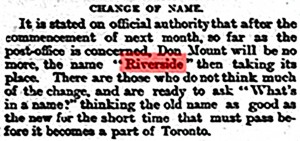Exploring how, when and why Riverside got its name
(Read all the Uncovering Series)
 Uncovering the history of anything includes being part of a search for something bigger than one’s self. It stretches through time and space and to make sense of it requires asking questions like “Why is it called Riverside?” Wading through newspaper archives, ads for books published by Riverside Press at Oxford, battles in the Crimea and navigational reports from Chicago and N.Y. reveal an August 19, 1880 Toronto Evening Globe clipping.
Uncovering the history of anything includes being part of a search for something bigger than one’s self. It stretches through time and space and to make sense of it requires asking questions like “Why is it called Riverside?” Wading through newspaper archives, ads for books published by Riverside Press at Oxford, battles in the Crimea and navigational reports from Chicago and N.Y. reveal an August 19, 1880 Toronto Evening Globe clipping.
Not everyone thought this particularly important at the time, seeing amalgamation with the City of Toronto as the next logical development that would change the status quo for the better. For reasons not yet in evidence, the Dominion Government thought it worthwhile to use the name “Riverside”, and the search goes on to find a reason why. We can look back and try to imagine what life was like for the people living east of the Don.


In this southeast section of the 1878 York County Atlas map we can see the Grand Trunk Railway cross the Don, just north of the marsh through which the river finds its way into both the Toronto Harbour and Ashbridge’s Bay.

Don Mount clearly refers to the heights along the east side of the river with the location of the post office shown at the intersection of Scadding Street (Broadview Avenue) on the south side of the Kingston Road (Queen St).

The P.O. is inside the city limits, close to the toll gate, which is hard to see on the enlarged 1878 map. The 1884 Goad’s Fire Insurance Map (below) shows the construction of each building, red for brick, yellow for wood, as well as the location of the “toll house” in the intersection on the eve of annexation, March 25 1884.

See detailed map of Riverside 1884 – credit to “Atlas of the City of Toronto by the Chas. E. Goad Company”
To understand the heart of Riverside then and what the future holds for us today is part of a mystery that drives this ongoing search. We continue to uncover the bits and pieces between the milestones in the history of Riverside, to further our understanding of this unique neighbourhood.
– Barry Slater, historian of the Royal Canadian Curling Club
